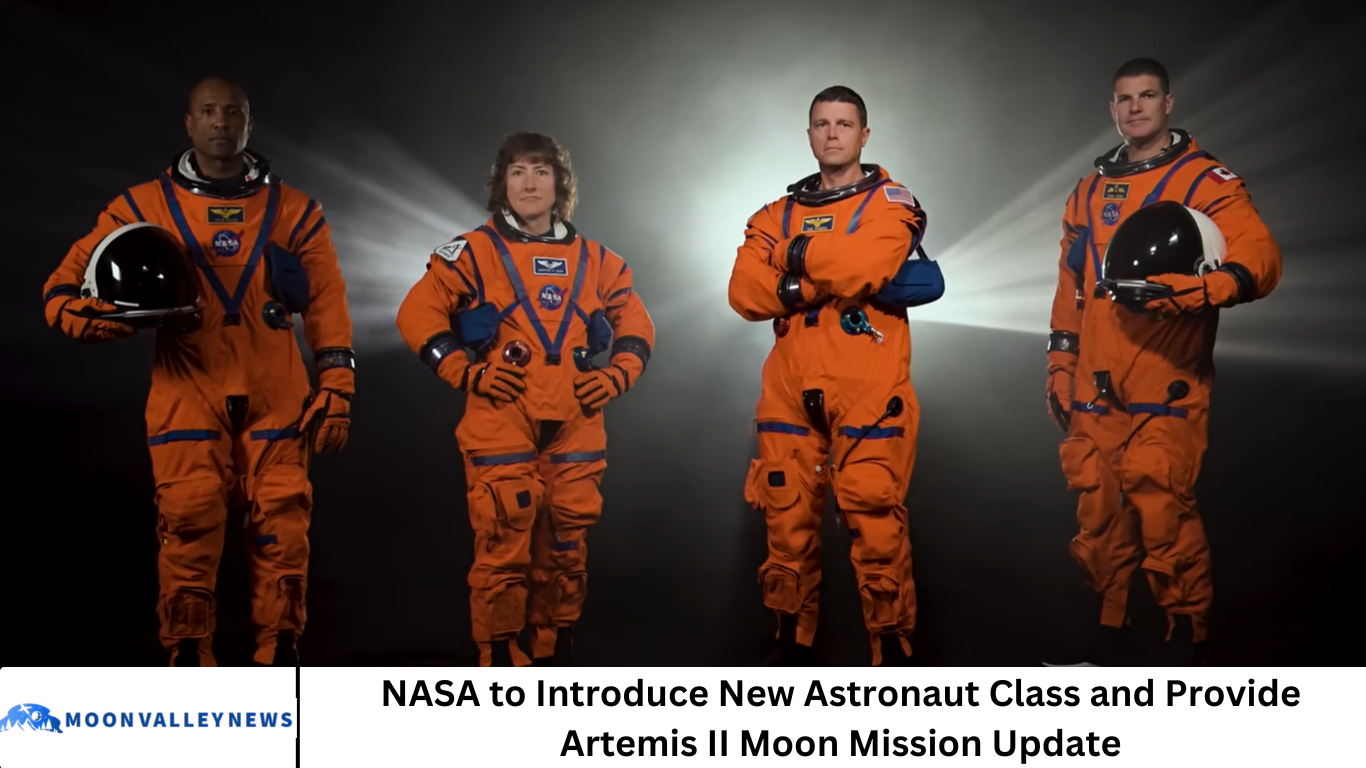HOUSTON, TX – September 3, 2025 — NASA is preparing for a historic multi-day event this September at the Johnson Space Center in Houston, where the agency will unveil its highly anticipated 2025 astronaut class and offer in-depth updates on the upcoming Artemis II crewed mission to the Moon. These events mark a major milestone in NASA’s human spaceflight program, as the agency accelerates its plans for sustainable lunar exploration and eventual crewed missions to Mars.
The back-to-back media events will spotlight the newest astronaut candidates chosen from a competitive pool of over 8,000 applicants, while also offering exclusive insight into the first crewed Artemis mission, which is scheduled to launch no later than April 2026.
With significant public and global interest in space exploration, NASA is making these events accessible to the public and media through multiple live streaming platforms, including NASA+, YouTube, Netflix, Amazon Prime, and X (formerly Twitter). Here’s everything you need to know about the upcoming astronaut class announcement, the Artemis II mission briefings, and what this means for the future of American space exploration.
More Raed: Israel’s Reaction to Journalist Killings Reflects Trump-Era Influence
NASA’s 2025 Astronaut Class: The Next Generation of Space Explorers
On Monday, September 22, at 12:30 p.m. EDT, NASA will introduce its 2025 class of astronaut candidates in a live ceremony at the Johnson Space Center. These individuals represent the next generation of explorers who will help push the boundaries of human spaceflight — from low Earth orbit to deep space, including the Moon and Mars.
Rigorous Selection Process
NASA’s selection process is among the most competitive and rigorous in the world. From over 8,000 applications, only a handful of exceptional candidates were chosen based on their backgrounds in science, engineering, medicine, military service, and space-related research. Each new candidate will begin an intensive two-year training program that includes:
- Spacewalk and EVA (extravehicular activity) simulations
- Robotics training
- Flight training in T-38 jets
- International Space Station (ISS) systems operations
- Survival training
- Russian language instruction
Once they graduate, these astronauts will become flight-eligible and join a legacy of NASA space explorers who have lived and worked in space for more than six decades.
Media Access and Streaming Options
The astronaut reveal event will be open to accredited media and will stream live on:
- NASA+
- NASA’s YouTube Channel
- Netflix
- Amazon Prime Video
- NASA’s official X account (@NASA)
Following the announcement, the newly selected candidates will be available for media interviews, providing insights into their motivations, career paths, and future ambitions in space exploration.
Artemis II: NASA’s First Crewed Mission Around the Moon
Following the astronaut class reveal, NASA will shift focus to its next major mission milestone: Artemis II. This mission will be the first crewed test flight of the Space Launch System (SLS) rocket and Orion spacecraft, taking astronauts on a 10-day journey around the Moon and back.
Meet the Artemis II Crew
NASA has already announced the Artemis II crew, which includes three NASA astronauts and one from the Canadian Space Agency (CSA):
- Reid Wiseman – Mission Commander
- Victor Glover – Pilot
- Christina Koch – Mission Specialist
- Jeremy Hansen – Mission Specialist (CSA)
This diverse and experienced crew will serve as pioneers for humanity’s return to the lunar vicinity after more than 50 years.
Mission Objectives
Artemis II is not just a demonstration of capability—it is a critical test flight designed to verify the life-support systems, navigation, communication, and propulsion technologies required for deep space missions.
Key objectives include:
- Validating Orion’s performance in deep space
- Demonstrating SLS’s capability to launch crewed missions
- Testing re-entry and splashdown procedures
- Confirming crew health and safety protocols during lunar orbit operations
This mission will pave the way for Artemis III, which will attempt the first crewed lunar landing of the Artemis era, including the first woman and first person of color on the Moon.
Artemis II Briefings and Media Day: September 23–24
NASA will host a series of media briefings on Tuesday, Sept. 23, and Wednesday, Sept. 24, to preview the Artemis II mission in greater detail. These sessions will include updates from NASA leadership, mission flight directors, engineers, and the Artemis II crew.
Live Streams and Access
All Artemis II briefings will be streamed on:
- NASA’s YouTube Channel
- NASA’s X (Twitter) account
- NASA+ platform
The content will also be made available on-demand for later viewing, ensuring global access for space enthusiasts and the general public.
Artemis II Media Day – Sept. 24
NASA’s Artemis II Media Day on Wednesday, Sept. 24, will include:
- Facility tours of training environments and mission support rooms
- Demonstrations of lunar mission hardware and simulators
- One-on-one interview opportunities with astronauts, scientists, engineers, and mission controllers
- Briefings from top NASA leadership on Artemis campaign goals
How to Apply for Media Accreditation
NASA is encouraging media representatives — both domestic and international — to register for in-person participation. Interested outlets and journalists must contact the NASA Johnson newsroom by the appropriate deadlines:
- U.S. Media: Apply by 5 p.m. EDT, Wednesday, Sept. 17
- International Media: Apply by 5 p.m. EDT, Wednesday, Sept. 10
All media inquiries, interview requests, and attendance confirmations should be sent to [email protected] or by calling 281-483-5111.
NASA’s full media accreditation policy can be reviewed on the agency’s official website.
Why This Matters: The Future of Human Spaceflight
Preparing for Mars
The Artemis program is not just about going back to the Moon. It’s about building a sustainable presence on the lunar surface that serves as a testbed for human missions to Mars. The technologies, crew dynamics, and systems tested during Artemis II will inform the design of future deep space missions.
International Collaboration
The inclusion of Canadian astronaut Jeremy Hansen underscores the collaborative nature of Artemis. NASA is working with international partners including the European Space Agency (ESA), CSA, JAXA (Japan), and commercial industry leaders like SpaceX, Blue Origin, and Lockheed Martin to build a truly global lunar exploration program.
Inspiring a New Generation
With this new astronaut class and the Artemis II mission, NASA is reinvigorating public interest in space and inspiring a new generation of scientists, engineers, and explorers. These events offer a moment to reflect on how far human spaceflight has come—and where it’s going next.
How to Watch: Streaming and Platforms
NASA is making all events widely available through both traditional and streaming media. You can tune in live or catch replays on the following platforms:
- NASA+ – Watch Here
- YouTube – NASA Channel
- Amazon Prime Video – Search “NASA Live”
- Netflix – Featured live streaming event
- X (Twitter) – @NASA
Set reminders, subscribe, or follow NASA on your favorite platform to stay updated.
Frequently Asked Question
When will NASA introduce the new astronaut class?
NASA will introduce its 2025 astronaut class during a live ceremony at 12:30 p.m. EDT on Monday, September 22, 2025, at the Johnson Space Center in Houston, Texas. The event will be streamed live across multiple platforms including NASA+, YouTube, Netflix, Amazon Prime, and X (formerly Twitter).
How many people applied, and how were the astronaut candidates selected?
More than 8,000 individuals applied to be part of NASA’s 2025 astronaut class. After a rigorous review and selection process involving interviews, medical evaluations, and skill assessments, only a select group of elite candidates were chosen. They will undergo nearly two years of training before becoming flight-eligible astronauts.
What is the Artemis II mission, and when will it launch?
Artemis II is the first crewed mission of NASA’s Artemis program, set to launch no later than April 2026. It will send four astronauts — including one from the Canadian Space Agency — on a 10-day mission around the Moon using NASA’s Space Launch System (SLS) rocket and the Orion spacecraft. This mission will test key systems needed for future deep space exploration.
Who are the astronauts flying on Artemis II?
The Artemis II crew includes:
- Reid Wiseman (Commander, NASA)
- Victor Glover (Pilot, NASA)
- Christina Koch (Mission Specialist, NASA)
- Jeremy Hansen (Mission Specialist, Canadian Space Agency)
They will be the first humans to travel around the Moon in over 50 years.
Where and how can I watch the events live?
Both the astronaut class introduction and Artemis II mission briefings will stream live on:
- NASA+
- NASA’s YouTube Channel
- Netflix
- Amazon Prime Video
- NASA’s X (Twitter) account
Recordings will also be available for later viewing on these platforms.
What’s happening during the Artemis II briefings and media day?
On September 23 and 24, 2025, NASA will host Artemis II mission briefings and a media day that includes:
- Updates from mission experts and astronauts
- Tours of training facilities and lunar mission hardware
- Interviews with engineers, scientists, and flight directors
These events are designed to provide in-depth insight into Artemis II’s goals and preparations.
Can the public or media attend these events in person?
Media representatives can attend the events in person by applying for accreditation through the NASA Johnson newsroom. Deadlines are:
- U.S. Media: Apply by 5 p.m. EDT, Wednesday, Sept. 17
- International Media: Apply by 5 p.m. EDT, Wednesday, Sept. 10
The general public can watch online but cannot attend in person due to security and facility access restrictions.
Conclusion
From unveiling America’s newest astronaut class to providing detailed previews of Artemis II, NASA’s upcoming events in September 2025 represent a major leap forward in space exploration, human presence beyond Earth, and international scientific collaboration. The world will be watching as NASA introduces the faces of the future and prepares for the first humans to return to the vicinity of the Moon since the Apollo era. With Artemis II on the horizon, the journey to the Moon—and beyond—is no longer science fiction, but a science-driven reality.






